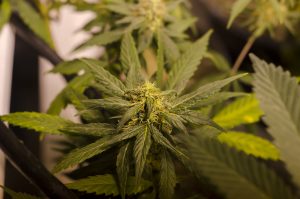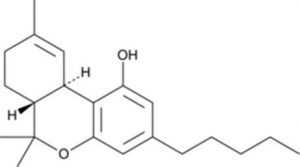by Kevin Shanks, M.S., D-ABFT-FT
Marijuana, also known as cannabis, is a genus of annual flowering plants in the family Cannabaceae, and consists of the species, Cannabis sativa and Cannabis indica. The plants are native to Eastern Asia, but are cultivated all over the world. Cannabis is considered a Schedule I controlled substance by the United States Federal government, but it is legalized for medical use in 36 states and the District of Columbia (DC) and for recreational use in 18 states and DC.

Marijuana plant.
‘Legal Colorado Marijuana Grow” by Brett Levin Photography is licensed under CC BY 2.0.
The plant contains more than 500 different compounds. At least 113 of the compounds are classified as cannabinoids. The major cannabinoid is Delta-9-tetrahydrocannibinol (THC), but others include tetrahydrocannabinolic acid (THCA), cannabidiol (CBD), cannabigerol (CBG), cannabinol (CBN), and tetrahydrocannabinolic acid (THCA). Other compounds in the plant include terpenes, such as alpha-pinene, limonene, linalool, and myrcene.

Chemical Structure of Delta-9-THC
Structure drawn by Kevin G. Shanks (2021)
THC binds to the endocannabinoid system in the body. Cannabinoid receptor 1 (CB1) is primarily located in the brain and spinal cord, while cannabinoid receptor 2 (CB2) is found in the gastrointestinal system, the immune system, and the peripheral nervous system. THC binds to these receptors and acts as a partial agonist, which means it activates them, but only has partial ability to produce a maximal response.
THC’s effects will vary according to the dose consumed, the potency of the substance, the route of administration, and the individual’s use history with the substance. When inhaled via smoking the plant or vaping THC oil, effects typically occur within minutes and last for a few hours. If taken orally via an edible such as THC-infused gummy candy and cookies, effects normally take 30-90 minutes to occur and last for 4-6 hours. Effects on the body include drowsiness, relaxation, relaxed inhibitions, altered time, altered perception, impaired learning and memory, difficulty in concentration and thought formation, and euphoria. Physiological effects include dry mouth, increased appetite, red eyes, and tachycardia.

Cannabis Edibles.
“THC-Infused Gummies” by THCProductPhotos is licensed under CC BY-ND 2.0
THC is metabolized in the liver primarily by the CYP2C9, CYP2C19, CYP2D6, and CYP3A4 enzymes to hundreds of detectable metabolites, with the main metabolites being the pharmacologically active 11-hydroxy-THC (11-OH-THC) and the pharmacologically inactive 11-nor-9-carboxy-THC (THC-COOH). THC-COOH is further conjugated with glucuronic acid and then excreted out of the body via the feces and urine.
Detection windows for the metabolite can be quite extensive and will vary according to the dose used, duration of use, and the individual using the substance. Frequent users of THC could have detectable levels of THC-COOH in their urine for up to 30 days or longer after cessation of use. Most infrequent users eliminate the metabolite within a few days up to a week after use.
A forensic toxicology lab can test for THC using many different types of instrument platforms. The initial screening test can be an immunoassay test, but can also be completed via gas chromatography with mass spectrometry (GC-MS), liquid chromatography with high resolution mass spectrometry (LC-QToF-MS) or liquid chromatography with triple quadrupole mass spectrometry (LC-MS/MS). Confirmatory testing is usually completed by either GC-MS or LC-MS/MS. In blood, both parent THC and, at minimum, the THC-COOH metabolite is monitored. Normal reporting limits for blood testing are 0.5-1 ng/mL for THC and 1-10 ng/mL for THC-COOH. In urine, labs typically only monitor THC-COOH with reporting limits for positive determination varying widely (5-300 ng/mL). The current scope of testing and screening and confirmation reporting limits offered by Axis Forensic Toxicology can be found in the online test catalog.
References
- Tetrahydrocannabinol. Disposition of Toxic Drugs and Chemicals in Man. Twelfth Edition. Randall C. Baselt. Biomedical Publications. Pages 2041-2045. (2020).
- Cannabis. Principles of Forensic Toxicology. Fifth Edition. Marilyn A. Huestis, Barry S. Levine, Sarah Kerrigan. Springer Nature Switzerland AG. Pages 389-448 (2020).
